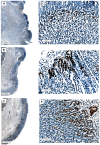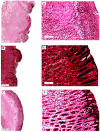Rhamnogalacturonan from Acmella oleracea (L.) R.K. Jansen: gastroprotective and ulcer healing properties in rats
- PMID: 24416280
- PMCID: PMC3885607
- DOI: 10.1371/journal.pone.0084762
Rhamnogalacturonan from Acmella oleracea (L.) R.K. Jansen: gastroprotective and ulcer healing properties in rats
Abstract
A rhamnogalacturonan (RGal) isolated from Acmella oleracea (L.) R.K. Jansen administered by oral route showed gastroprotective activity against acute lesions induced by ethanol. In this study, we investigated the gastric ulcer healing effect of RGal and its mechanisms of action. Intraperitoneal treatment of animals with RGal protected the gastric mucosa against acute lesions induced by ethanol, with participation of gastric mucus. Furthermore, in the chronic ulcer model, oral administration of RGal accelerates the gastric ulcer healing, accompanied by increasing of cellular proliferation and gastric mucus content, reducing inflammatory parameters and oxidative stress. In addition, the repeated 7 days-treatment of animals with RGal did not show alterations of clinical and behavioral symptoms, body and organs weights or plasmatic biochemical parameters. Collectively, these results showed that RGal has an interesting antiulcerogenic activity and could constitute an attractive molecule of interest for the development of new antiulcer agents.
Conflict of interest statement
Figures








Similar articles
-
Antiulcer mechanisms of Vernonia condensata Baker: A medicinal plant used in the treatment of gastritis and gastric ulcer.J Ethnopharmacol. 2016 May 26;184:196-207. doi: 10.1016/j.jep.2016.02.049. Epub 2016 Mar 5. J Ethnopharmacol. 2016. PMID: 26956376
-
Evidence of gastric ulcer healing activity of Maytenus robusta Reissek: In vitro and in vivo studies.J Ethnopharmacol. 2015 Dec 4;175:75-85. doi: 10.1016/j.jep.2015.09.006. Epub 2015 Sep 10. J Ethnopharmacol. 2015. PMID: 26364940
-
Cochlospermum regium (Mart. ex Schrank) Pilg.: Evaluation of chemical profile, gastroprotective activity and mechanism of action of hydroethanolic extract of its xylopodium in acute and chronic experimental models.J Ethnopharmacol. 2019 Apr 6;233:101-114. doi: 10.1016/j.jep.2019.01.002. Epub 2019 Jan 3. J Ethnopharmacol. 2019. PMID: 30611907
-
Effects of the Anthocyanin Hirsutidin on Gastric Ulcers: Improved Healing through Antioxidant Mechanisms.J Nat Prod. 2022 Oct 28;85(10):2406-2412. doi: 10.1021/acs.jnatprod.2c00620. Epub 2022 Oct 10. J Nat Prod. 2022. PMID: 36215657 Review.
-
The Role of Triterpenoids in Gastric Ulcer: Mechanisms and Therapeutic Potentials.Int J Mol Sci. 2025 Mar 31;26(7):3237. doi: 10.3390/ijms26073237. Int J Mol Sci. 2025. PMID: 40244034 Free PMC article. Review.
Cited by
-
Potential use of the Asteraceae family as a cure for diabetes: A review of ethnopharmacology to modern day drug and nutraceuticals developments.Front Pharmacol. 2023 Aug 3;14:1153600. doi: 10.3389/fphar.2023.1153600. eCollection 2023. Front Pharmacol. 2023. PMID: 37608892 Free PMC article. Review.
-
Amazonian useful plants described in the book "Le Pays des Amazones" (1885) of the Brazilian propagandist Baron de Santa-Anna Nery: a historical and ethnobotanical perspective.J Ethnobiol Ethnomed. 2024 Feb 26;20(1):26. doi: 10.1186/s13002-024-00663-2. J Ethnobiol Ethnomed. 2024. PMID: 38409064 Free PMC article.
-
Use of Some Asteraceae Plants for the Treatment of Wounds: From Ethnopharmacological Studies to Scientific Evidences.Front Pharmacol. 2018 Aug 21;9:784. doi: 10.3389/fphar.2018.00784. eCollection 2018. Front Pharmacol. 2018. PMID: 30186158 Free PMC article. Review.
-
Phyto-Mediated Photo Catalysed Green Synthesis of Silver Nanoparticles Using Durio Zibethinus Seed Extract: Antimicrobial and Cytotoxic Activity and Photocatalytic Applications.Molecules. 2018 Dec 13;23(12):3311. doi: 10.3390/molecules23123311. Molecules. 2018. PMID: 30551671 Free PMC article.
-
Pomegranate Mesocarp against Colitis-Induced Visceral Pain in Rats: Effects of a Decoction and Its Fractions.Int J Mol Sci. 2020 Jun 17;21(12):4304. doi: 10.3390/ijms21124304. Int J Mol Sci. 2020. PMID: 32560291 Free PMC article.
References
-
- Ratnasooriya WD, Pieris KP, Samaratunga U, Jayakody JR (2004) Diuretic activity of Spilanthes acmella flowers in rats. J Ethnopharmacol 91: 317–320. - PubMed
-
- Ekanem AP, Wang M, Simon JE, Moreno DA (2007) Antiobesity properties of two African plants (Afromomum meleguetta and Spilanthes acmella) by pancreatic lipase inhibition. Phytother Res 21: 1253–1255. - PubMed
-
- Wu LC, Fan NC, Lin MH, Chu IR, Huang SJ, et al. (2008) Anti-inflammatory effect of spilanthol from Spilanthes acmella on murine macrophage by down-regulating LPS-induced inflammatory mediators. J Agric Food Chem 56: 2341–2349. - PubMed
Publication types
MeSH terms
Substances
LinkOut - more resources
Full Text Sources
Other Literature Sources

